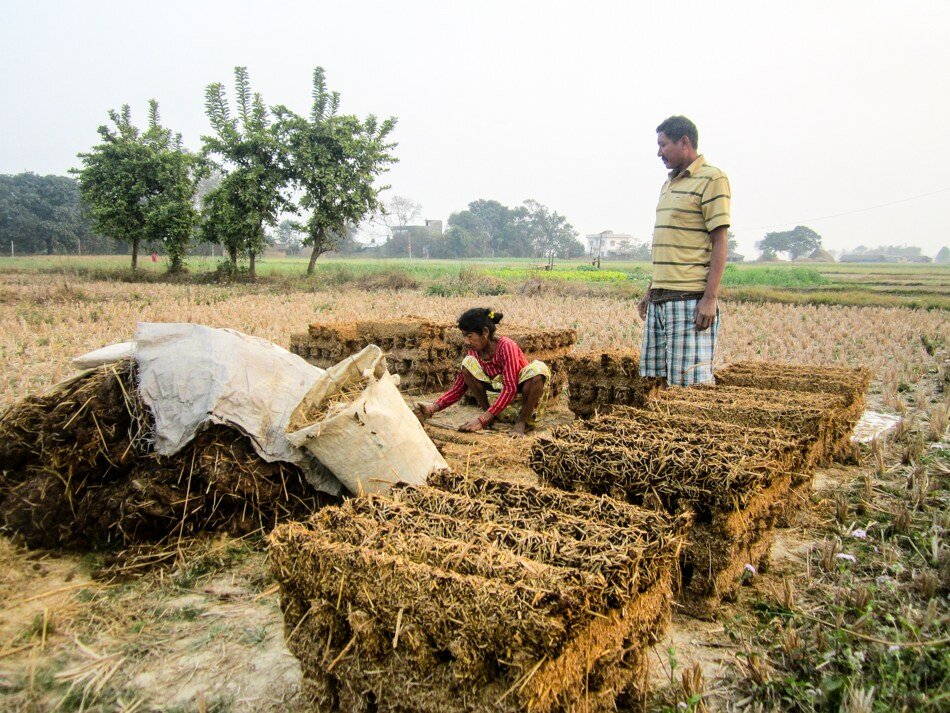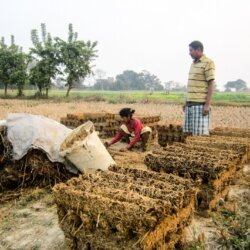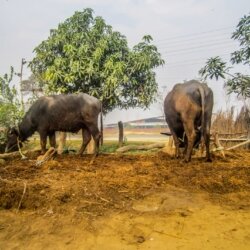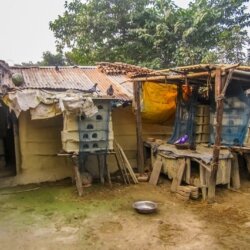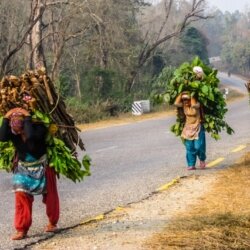Can Nepal defeat its deepening energy crisis?
Unable to harness its immense hydro potential and squeezed by a powerful neighbour, can Nepal find a way to provide reliable, clean energy to its most vulnerable citizens?

Part 1
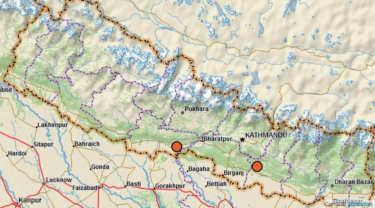
NEPAL
- Population: 27.8 million people
- Electrification rate: 76.00%
- Renewable energy consumption: 84.72%
- Access to non-solid fuel: 20.45%
Source: World Bank
BHORLENI, NEPAL — Squatting over a smoldering fire that heats two giant aluminum pots, Surya Maya Lama stirs a pungent local brew. Slivers of sunlight seep through the bamboo, illuminating the clay-wood hut as an older woman adds cold water to the blackened pots. Called raksi in Nepali, this moonshine contains 50 per cent alcohol and is illegal to produce for commercial purposes. Nevertheless, the 28-year-old and her family sell it at their eatery in this small riverside village in southeastern Nepal.
A police crackdown on moonshine is the least of concerns for Tamangs, the indigenous people who call this remote hamlet home. Like so many others living in remote Nepali communities, they must spend much of their working hours in search of firewood. A few days earlier, Lama and the women of her family trudged up a hill in search of wood, searching for an hour and a half.
The alcohol is not only energy intensive, it also consumes a lot of water to distill the fermented rice or millet into strong, sharp liquor. “We need about 15 kilograms of firewood to make roughly 10 litres of raksi,” Lama said. “It takes a lot of firewood. But this is all I know; it has been our way of life and livelihood as far as I can recall.” She added: “If there’s any other way to minimize firewood, or cook it, we will happily adopt it.”
The huge amount of time people spend in collecting firewood is not acceptable in the modern world.
At present the Nepali government is under immense pressure to tackle the health-threatening indoor air pollution caused by traditional cook stoves like Lama’s. Every year, an estimated 7,500 people in Nepal — mostly women and children — die from respiratory diseases largely attributed to the smoke from open fires.
“The costs are simply too high. It is not only detrimental to health, people are also suffering by losing the productive hours that they would have otherwise spent for productive engagements,” says Bibek Raj Kandel, National Advisor for Institutional Development at the Alternative Energy Promotion Center (AEPC), the state body that promotes renewable energy. “The huge amount of time people spend in collecting firewood is not acceptable in the modern world.”
Hybrid solar and wind — part of the solution
The answer to at least some of Lama’s energy challenges is just outside her front door — on a small field at the edge of the village, two giant wind turbines stand, the turbine blades whirring idly as people go about their work. Nearby are 126 solar panels shimmering in the afternoon sun.
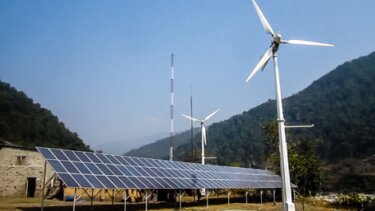
The 25 kilowatt hybrid solar (15 KW) and wind (10 KW) plant began its operation last summer, but was formally inaugurated late last year. The 13-million rupee (US$120,522) project, funded by government and locals, has electrified 131 households of Bhorleni. Lama is one of the beneficiaries of the project (she now has home lighting), but her energy needs for cooking are not met by the plant.
The project is part of Nepal’s urgent program to electrify off-grid, poor and remote communities and encourage locally generated, clean microgrid systems. Without any major oil, gas or coal reserves, Nepal’s per capita energy consumption is one of the lowest in South Asia and well below the average for Asia. Daily energy use here remains dominated by primitive methods of cooking and heating with biomass.
An interview with Padam Ghalan, chairman of Wind and Solar Energy Users’ Committee, Bhorleni, Nepal
At a time when much of the Western world is shifting toward renewable energy, rural communities in Nepal still rely on traditional energy sources, while fast urbanizing cities, towns and some villages have only recently transitioned to clean cooking, with fuels such as liquefied petroleum gas. Despite huge potential to generate hydropower from its vast network of fast flowing Himalayan rivers, the country is dependent on its massive neighbour India for about 15 per cent of its energy (including hydro and petroleum products), leaving energy supply vulnerable to embargo and geopolitical whim.
COOKING IN NEPAL
Nepal government data show that cooking takes the lion’s share of energy. Biomass, including fuelwood and agricultural waste used mostly for cooking, accounts for nearly 80 per cent of the country’s total energy use (this is an aggregate figure, burning of wood and plant residue is higher in rural areas) . Petroleum products account for 12 per cent, coal four per cent and electricity and renewable energy each three per cent of the country’s energy use. The residential sector consumes 80 per cent of available energy. The remaining goes to transport (eight per cent), industry (seven per cent), commercial (four per cent) and agriculture (one per cent). Seventy-six per cent of the country’s 26.6 million people have access to electricity.
How clean energy came to Bhorleni
Bhorleni is a natural spot for a wind farm — in places, the wind blows consistently from 5:30 p.m. until 10 a.m.
“We are glad that the government built the plant here,” says 28-year-old Padam Ghalan, a Chairman with the village’s Wind and Solar Energy Users’ Committee, who also donated a parcel of his land to the project. “Until a few months back, we had to walk for several hours to charge our mobile phones. We no longer worry about how to charge our phone. We can even watch TV and learn about what’s going on in our country and across the world.”
The 11-member committee headed by Ghalan is currently devising a cost structure: the price will be a minimum of US$1.40 for each household, and more if a home has electric appliances, like a TV or fridge.
The hybrid plant, the second of its kind in Nepal, is a scaled-up version of a similar Asian Development Bank-funded 12 KW solar and wind hybrid plant in the village of Dhaubadi in the Nawalparasi district. Now a local cooperative runs the project, charging US$2.80 a month per household.
“We wanted to replicate that model,” said Prakash Aryal, a Manager for the Wind Energy subcomponent of AEPC. “In 2012, we were looking for three possible sites to scale that up. Bhorleni fitted our criteria as the village was hard to reach, off-grid and inhabited by marginalized Tamang people, who were willing to cooperate and contribute to it.”
Aside from raising over US$28,000, the locals also contributed labour during construction. The AEPC later helped train two local people to operate the plant. The company that installed the hybrid plant will carry out maintenance service for the first three years: while the solar system does not require much technical support, the wind blades, which rotate with the help of bearings, will require future maintenance.
“The idea is to empower the local communities to have access to energy,” said Aryal. “This is not a long-term solution. We support them in the interim. Our goal is to help them have access to lighting before the national power grid reaches them.”
For now, that is still a farfetched dream.
A long road to energy access
Nepal is working toward achieving universal electrification. By the end of 2017, when the government’s 13th three-year plan winds up, it plans to electrify 87 per cent of households. The government also hopes to make all households smokeless by 2017. To meet the latter target, two million households will have to switch from traditional stoves to improved cooking stoves. (So far, the AEPC has distributed improved cooking stoves to 1.2 million households.)
Nepal’s off-grid energy policies are formulated with the goal of alleviating poverty, says Kandel, the AEPC advisor. By providing better lighting and cooking solutions, the government aims to simultaneously improve other aspects of social welfare. “Better energy services can open up new economic opportunities,” says Kandel. “It’s part of the country’s development agenda.”
An interview with Gyani Maiya Shrestha, a homemaker in Phaparbari, Makwanpur, Nepal
All of Nepal’s ambitious energy targets are in the hands of the AEPC, which was set up in 1996 to promote community-based decentralized renewable energy projects. Prior to that, the only work on renewable energy involved biogas and micro hydropower initiated by the state-run Agriculture Development Bank in the 1970s. In the 20 years since its founding, the AEPC has evolved into a renewable energy behemoth. Danish and Norwegian aid groups and the United Nations Development Programme supported its various projects. It began work in five of Nepal’s 75 districts. Today, it works in all 75 districts, with an energy, environment and climate change officer in each. It employs 500 people and its central office building in Lalitpur district, south of Kathmandu, has a 41 KW rooftop solar photovoltaic system, the largest such plant for an institution in Nepal.
The AEPC works through 11 of its renewable energy centres spread across the country, with two in Kathmandu. These centres work as focal points that create demand, facilitate and assure quality.
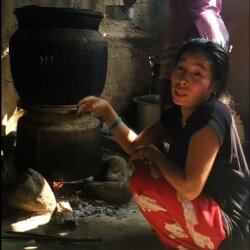
THE TROUBLE WITH SUBSIDIES
The AEPC trains stove masters to build improved cooking stoves, and subsidizes metallic cooking stoves for the residents of high altitude Himalayan regions. In recent years, however, calls for phasing out the subsidy regime and replacing it with a market driven approach have grown louder. “We provide subsidy to end users. There’s nothing for the private sector developers or energy service companies,” Kandel said. “Nepal’s problem is how to transition from subsidy to an approach based on market.”
Kandel says the entire energy sector is so heavily dependent on subsidies and continued donor support that, when subsidies are reduced or a major donors exits, there are tremendous disruptions to the system.
“We must incentivize innovative business ideas and service delivery models for the sustained growth of the sector. This can be done by providing lower interest rates to project developers, or to energy service companies or by providing tax waivers, lucrative feed in tariff rates, purchase guarantees and so on,” he said.
Indian energy blockade causing energy hardship
Traveling through a section of Nepal’s east-west Mahendra Highway, the country’s main artery, it was apparent that even Nepal’s more affluent citizens are grappling with an energy crisis.
Nirmala Shrestha, 30, was among a group of five women walking on the highway shoulder in Daunne of Nawalparasi district (about 200 kilometres from Bhorleni) one afternoon in early February, her back bending with a load of twigs and tree branches. It had been a long day for the mother of two young girls; she began the trip mid-morning.
WHY DO YOU CARE ABOUT ENERGY SOLUTIONS?
Tell us why these stories matter and what you’ll do with this information.
When the local cooking gas seller started rationing fuel, Shrestha and others decided to take matters into their own hands. “If you buy this much firewood, it costs you US$7.47. So we decided to collect it ourselves,” she said.
The tropical forest with sal and other broadleaf trees is managed by one of Nepal’s community forest groups, which allows people like Shrestha to collect fuelwood twice a week. She wasn’t exactly running out of energy, but was rather hoarding multiple energy sources, a trend that emerged following an economic embargo imposed by India, landlocked Nepal’s sole supplier of petroleum products, including petrol, diesel and cooking gas. “This will be enough for me to cook food for two weeks. We can’t buy cooking gas even if we have money.”
INDIA’S ENERGY EMBARGO ON NEPAL
The tiny South Asian nation of Nepal, which looks like a brick on a world map, is bordered by India on three sides. China, another Asian giant, lies to the north across the Himalayas. Historically, India, because of its size and proximity to Nepal, has exerted tremendous influence on its northern neighbour. In September last year, Nepal promulgated a much anticipated, post-war constitution. The Madhesis, an ethnic group in the southern plains with close relations across the border in India, opposed the constitution, saying that it further marginalized them. India backed their protests by halting supplies of daily commodities including petroleum products, medicines and food. The blockade was lifted in early February on the eve of Nepal’s Prime Minister’s visit to India, but the fuel supply, which had been overtaken by black marketers and smugglers, has yet to return to normal. In Kathmandu, most petrol stations have not resumed regular service; motorcycles and cars still wait for hours near the petrol stations that ration the fuel.
Shrestha’s husband served in the Indian Army as a Gorkha soldier, a mercenary in a two-century-old recruitment system established by British after they lost the war with Nepal in 1816. The irony of her husband’s sacrifice for the armed forces of the same country that cut their energy lifeline was not lost on Shrestha, but she was guarded about it. “This is the reality we have been facing in Nepal.”
With India exacerbating the energy crisis, Nepal’s government has been under pressure to find solutions to the energy challenges facing the country. On Feb. 18, the government of K.P. Sharma Oli, a nationalist politician heading a fragile coalition, announced an “energy emergency,” pledging to end the rolling blackouts within two years. With a legacy of past announcements to produce thousands of megawatts of electricity that have yet to translate into reality, the latest pledge has a lot of skeptics.
Energy experts like Anirudh Sah say Nepal has a long way to go. “In developed countries, a large amount of energy is used for industry, but in Nepal, households are the largest consumers of energy. We need to change this and optimize our energy production,” he said.
Sah sees hope in the hybrid model. “For renewable energy to gain growth, the hybrid model, between wind and solar, is the best way [forward] because both of these provide intermittent energy and can complement each other,” he said.
But for Bhorleni residents like Surya Maya Lama, who continue to cook food using firewood on traditional stoves, such technology can, at best, bring only partial benefit for now.
Part 2
Life at the bottom of Nepal's energy pyramid
JAMUWAD, NEPAL — Hidden behind a mini-mountain of livestock manure, Malati Chaudhary scooped up a mound of buffalo dung using her bare hands and mixed it with hay. She measured the metre-long dung cake with a stick and added more hay as her husband, Bishwa Nath Chaudhary, towered over her. She deftly inserted twigs into the elongated piece and molded it into slender pillars of solid fuel. The 36-year-old placed it over a row of dung portions, letting it dry in the sun, which was setting in the village of Jamuwad in Nepal’s south-central Nawalparasi district.
The Chaudharys, indigenous members of the Tharu minority community living in the southern plains bordering India, were stockpiling precious solid biofuel for summer, the farming family’s busiest season of the year. The nine-member family that lives in an unfinished and unfurnished one-story concrete home by a highway, was continuing a tradition dating back centuries.
Malati Chaudhary and her husband Bishwanath Chaudhary produce dry dung for the summer, a centuries-old method of making fuel, in Parasi village of Nawalparasi district in south-central Nepal
People like the Chaudharys are at the bottom of Nepal’s energy pyramid. So are the communities living in the harsh terrain of the Himalayas. Once a prosperous community, tens of thousands of Tharus were driven out of their farmlands by high-caste hill immigrants. They were also forced into a bonded labour system, which was abolished only in 2000 following decades of servitude.
But as dusk fell, the 38-year-old family head had no time to waste over the bitter past of his community. He was working hard to save enough energy for the winter months and for the summer. The Chaudharys, like several of their neighbours, have accumulated all types of fuel to meet their cooking needs. Aside from animal dung, crop waste and firewood, the locals also secure modern forms of energy. An empty gas cylinder was gathering dust in a corner of their kitchen.
“Nowadays, we use residue from mustard plants, which will last for a month. The animal dung lasts for three months. Then, we also collect firewood and buy kerosene when it’s available,” said Chaudhary, a mustachioed man who works at a nearby paper mill drawing a monthly salary of 9,000 rupees (US$83). Adding woes to his already precarious life was last year’s drought, which diminished the production of mustard. The daily power outages that last for up to 14 hours in the winter, have hurt his 14-year-old daughter Pratima’s studies as an eighth grader. “It would be great if we had regular power supply, but it goes off in the evening when I need it most,” she said.
A look inside Chaudhary’s three-year-old dwelling revealed a house in a state of disorder. A single bulb lighted a room with a rickety fan and an old TV set. Another room had walls without cement coating. Scattered on the floor were potatoes, sacks of rice, cooking utensils and clothes. He has already spent half a million rupees (about US$7,500) on the building, but it is far from complete.
The most important source of energy for the Chaudhary household sat idly under a tiled roof outside their home. The water buffalo and her two calves can supply enough raw materials for a biogas plant that would cost about US$373. Biodegradable products such as animal dung and food waste can be fed into an underground digester, which converts it to methane. The gas in turn is supplied through pipes for household use. The dome-shaped plants are ideal for the plains environment with its hot climate and plenty of groundwater.
But the problem, again, is money. “A biogas plant would have solved my problem. But I can’t afford it,” said Chaudhary. “If I had one, I could have used the animal dung as fertilizer even after producing gas.”
